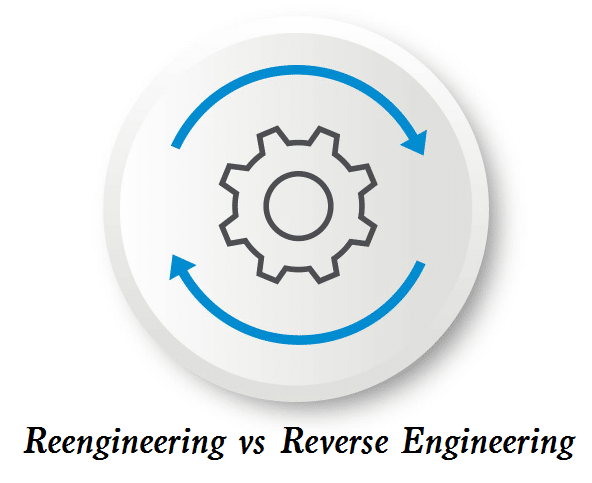Reverse engineering can be a complex process that requires expertise, specialized tools, and equipment. There is another term often mentioned – reengineering, how to distinguish reengineering and reverse engineering? We’ll talk about the differences between them and when should you use reverse engineering.

What Is Reengineering?
Reengineering, also known as business process reengineering (BPR), is a management approach that aims to improve the efficiency and effectiveness of an organization’s business processes. It involves a radical redesign of existing processes, rather than just making incremental improvements. The goal of reengineering is to identify and eliminate non-value-added activities and to streamline the remaining activities to achieve better results. This can involve a fundamental rethink of how work is organized and carried out, often using new technologies to support the redesigned processes. Reengineering can be a complex and time-consuming process, but it can significantly improve productivity, quality, and customer satisfaction. It requires a commitment to change from all levels of an organization and may involve restructuring or downsizing in some cases.
What Is Reverse Engineering?
Reverse engineering is the process of analyzing a product, system, or software in order to understand its design, architecture, and functionality. It involves taking apart a product or system to study its components, how they work together, and how they were designed. Reverse engineering can be used for a variety of purposes, such as:
- Understanding how a product works: By analyzing the components of a product, reverse engineering can help understand how it was designed and how it functions.
- Creating a copy of a product: Reverse engineering can be used to create a copy, often for competitive reasons.
- Improving a product: By understanding how a product works, reverse engineering can help identify ways to improve its design or functionality.
- Repairing a product: Reverse engineering can help identify the cause of a problem with a product and how to fix it.
Differences Between Reengineering and Reverse Engineering – Reengineering vs Reverse Engineering
Reverse engineering and reengineering are two distinct processes with different goals and approaches. Here are some of the main differences between them:
1) Goal: The goal of reverse engineering is to analyze an existing product or system to understand its design and functionality, while the goal of reengineering is to redesign and restructure an existing process or system to improve its efficiency and effectiveness.
2) Scope: Reverse engineering is typically focused on analyzing a single product or system, while reengineering is often applied to an entire process or system within an organization.
3) Methods: Reverse engineering often involves taking apart a product or system to study its components and design, while reengineering involves analyzing existing processes and redesigning them from scratch.
4) Tools: Reverse engineering often involves using specialized tools and equipment to analyze a product or system, while reengineering may involve using new technologies to support the redesigned processes.
5) Legal and ethical considerations: Reverse engineering can raise legal and ethical issues, such as intellectual property rights and patent infringement, while reengineering is typically focused on improving the efficiency and effectiveness of an existing process or system, without necessarily creating new products or systems.
When to Use Reverse Engineering?
Reverse engineering can be useful in a variety of situations where there is a need to understand the design, architecture, or functionality of an existing product, system, or software. Some common situations where reverse engineering may be used include:
- Product analysis: Reverse engineering can be used to analyze the design and functionality of an existing product, to identify ways to improve it, or to create a copy of it for competitive reasons.
- Legacy system migration: Reverse engineering can be used to analyze the architecture and design of a legacy system, to help migrate it to a new platform or technology.
- Security analysis: Reverse engineering can be used to identify vulnerabilities in software or systems, to help improve their security.
- Intellectual property disputes: Reverse engineering can be used to analyze a product or system to determine if it infringes on intellectual property rights.
- Repair and maintenance: Reverse engineering can be used to analyze the components and design of a product or system to help with repairs or maintenance.